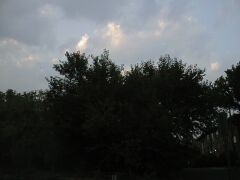Exposure Control and Neutral Density Filters
 visitors since September 11, 1998
visitors since September 11, 1998 visitors since September 11, 1998
visitors since September 11, 1998Using the camera's focus lock is a simple way of changing the exposure on the Epson (or most point and shoot digicams). However, it is quite crude -- you can't tell exactly what the results will be until after the fact.
A more accurate and flexible way of changing the camera's exposure setting is by using netural density filters. These are filters that reduce the amount of light entering the camera, but have no effect on the color of image. Neutral density filters come in varying "strengths," depending on how much light they let pass through. (To confuse matters, there are two different scales that are used to guage the amount of light that the filter allows through.) A filter that allows 50% of the light to pass (referred to as a ND2, or an 0.3, depending on the scale) will have less of an effect on the image than one only allows 25% (ND4 or 0.6) or 12.5% (ND8 or 0.9).
In order to use a neutral density filter to change the exposure you have to "trick" the camera. To get the camera to over-expose, or take a brighter picture:
1. Put the filter in front of the lens.
2. Push the shutter half way until the focus locks
3. Remove the filter.
4. Take the picture.
Using a ND2 or 0.3 will cause the camera to over-expose by 1 "stop," which means the camera will double its exposure length (or choose an aperture 1 setting larger). For example, instead of using a shutter speed of 1/250 the camera would choose a speed of 1/125. (Or instead of using an aperture of f11 it would use f8.) The result is that more light gets into the camera. Using a ND4 or 0.6 will cause the camera to over-expose by 2 stops (i.e. the camera quadruples its exposure length or selects an aperture 2 stops larger). Using a ND8 or 0.9 produces an over-exposure of 3 stops, etc.
 Underexposed 3 stops (0.9 filter) |
 No filters |
 Overexposed 3 stops (0.9 filter) |
To get the camera to under-expose, or take a darker picture:
1. Push the shutter half way until the focus locks.
2. Put the filter in front of the lens.
3. Take the picture.
How much the camera underexposes depends on the strength of the neutral density filter. An ND2 or 0.3 produces 1 "stop" underexposure, an ND4 or 0.6 produces 2 "stops", etc.
Where do you get a neutral density filter? Most good camera stores stock them, but you may have some trouble finding ones that fit onto the (typically) small threads used by digital cameras. I was unable to find anything stronger than a ND2 in my local camera stores. You could buy several and stack them, but you'd might run into vignetting problems. An easy solution is to make your own from gelatin film sheets. These are transparent plastic filter sheets. There are a range of different filters and colors available if you want to get creative, but you only need one neutral density sheet. My local store sells a 20 by 30 inch sheet (0.3 strength) for about $4. Since you only need enough material to cover your camera lens, this will give you a lot of filters!
 Gelatin filter sheets |
 Filter holder |
To make a more powerful filter, you can simply layer the material. Cut a few squares and layer them on top of each other to create 0.6, 0.9, 1.2, etc. filters. To make it easier to store and use the filters I've mounted a few between two thick cardboard "frames." It is easy to add or remove layers of the filter as needed.